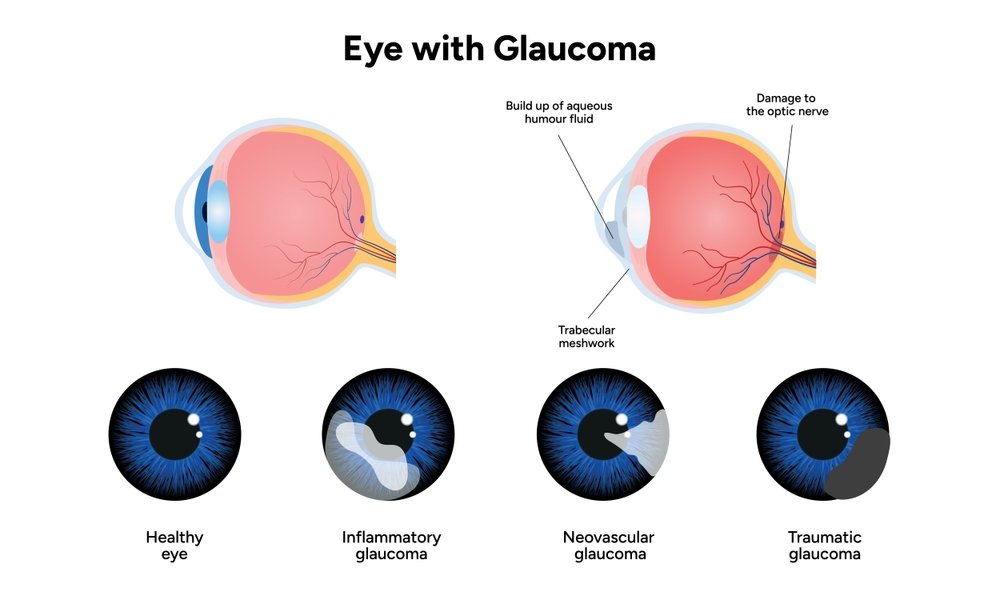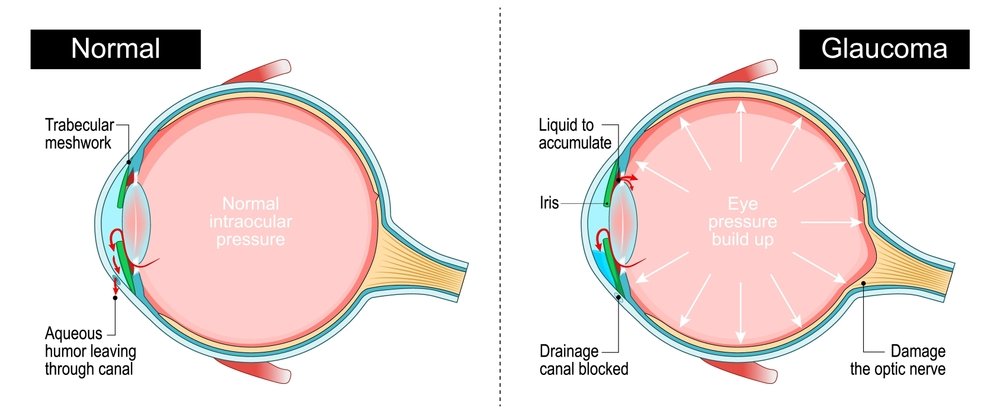Glaucoma is a family of eye diseases. It damages the optic nerve. This nerve carries image messages to the brain. If damaged, it can cause vision loss. It is often, though not always, associated with high pressure inside the eye. Actually, the most common condition in adults is hypertension, also known as high normal pressure. Thus, it can be said that glaucoma is currently one of the leading causes of blindness. If treated on time, serious harm will not occur. It is divided into two subtypes:open-angle glaucoma; and angle-closure glaucoma. Both have different effects on vision.
Glaucoma Symptoms

The glaucoma symptoms do vary. Symptoms in the early stages may not be present. Most people suffering from glaucoma never experience pain. Gradually, the loss of vision takes place. The loss typically occurs with peripheral vision. This means that your peripheral vision has significantly decreased before you know it. In some cases, the symptoms of it can therefore be acute. This includes blurred vision, headache, and eye pain. There may be vomiting or nausea. See your doctor right away if you experience any of the following symptoms. One condition that can be identified early with the aid of routine eye exams is glaucoma.
Glaucoma Causes
At some point, it becomes apparent that the exact aetiology of glaucoma cannot be identified. High ocular pressure, however, is the cause of the majority of instances. Aqueous humour, a fluid component of the eye, is one of the many parts that make up the eye.
It is a transparent fluid that fills the eye and typically drips out. In the case of obstruction of the drainage system, the fluid is retained. This in turn increases pressure on the eye leading to glaucoma. Glaucoma can occasionally be classified as normal pressure glaucoma.
In many situations, heredity has the largest share in the occurrence of diseases. It is unclear what raises a person’s chance of developing glaucoma. There are several risk factors you can infer based on your family history. Chronic causes include eye injuries, long-term steroid use, and chronic disorders such as diabetes.
Glaucoma Treatment
This is because the therapy of glaucoma consists of the decrease of eye pressure. Reducing the pressure slows the illness process and prevents the emergence of new complications. The objective is to try to retain as much vision as it is possible. Early treatment is key. Glaucoma can be managed using medications, laser surgery, as well as traditional surgery. The Glaucoma treatment type primarily depends on the degree of the affected portion of the body.
Glaucoma Eye Drops
Eye drops continue to be the most often utilized treatment for glaucoma. They help lower eye pressure. Glaucoma eye drops come in two categories. One type of receptor may slow down fluid production in the eyes, while another may boost fluid outflow. It should be used exactly as prescribed by a doctor. If the drug is withdrawn or doses are missing, glaucoma can worsen. Some of them can cause eye inflammation or a burning feeling with dry eyes and blurred vision. If you experience any side effects call your doctor. They can change your treatment.
Who treats Glaucoma?
A doctor with a medical degree who diagnoses and treats eye conditions is known as an ophthalmologist. They are capable of doing any kind of eye procedure, including examinations, treatments, and, in some situations, surgeries. If you visit your ophthalmologist for an eye exam and show signs of glaucoma, the condition can be diagnosed. Without a medical degree, a skilled optometrist can do an eye exam and detect glaucoma. These practitioners can recommend you to an ophthalmologist, who will treat you if necessary.
Glaucoma Test
In a glaucoma test, one measures for high pressure in the eyes or impaired optic nerve. The eye doctors may carry out several tests in an attempt to diagnose glaucoma. The most popular one is the tonometry test. This test measures the pressure inside an eye.
The physician uses a miniature instrument to pump air into an eye or by applying a probe. Another popular test is ophthalmoscopy. This enables the physician to examine the state of the optic nerve. A visual field test checks primarily for a person’s peripheral vision.
Other techniques, such as OCT (optical coherence tomography), are also used to check the condition of the optic nerve. These exams are painless and require only a short amount of time. Everyone should get their eyes tested once a year. However, this is especially crucial for those at higher risk.
Glaucoma Laser Surgery
Glaucoma laser surgery is also being investigated as a means of treatment for sufferers. Glaucoma pads are another treatment option under investigation. It reduces intraocular pressure. There are several distinct types of laser surgery. However, it is crucial to highlight that laser surgery is not limited to PET.
Selective laser trabeculoplasty (SLT) is by far the most frequent type. It is stated that the use of SLT enhances the facility of aqueous humour drainage in the eye. The other type is laser iridotomy. It is in angle-closure glaucoma, and the laser opens up a hole in the iris for better drainage.
They by and large recommended laser surgery where the medication fails to work out. It is often not as invasive as invasive surgical procedures. Laser surgery is normally painless, and the majority of patients recover quickly thereafter. It is not a cure; you will require additional therapy at some time in your life at least.
Can Glaucoma Be Stopped?
This glaucoma damage is irreparable; the problem is for life. However, various types of medications and procedures can be used to keep this condition from worsening any further. Therefore, the eye doctor may prescribe one or more of the following in the treatment of glaucoma.
What self-care measures can someone with glaucoma take?

There are several ways that you can manage glaucoma and help yourself:
The most important advice for glaucoma patients is to follow the suggestions of the eye expert who is treating the condition. They may also request you to adjust some facet of your lifestyle, behaviour or schedule. These are:
- Do not ignore any new symptoms or changes in your glaucoma vision
- Reach and maintain a weight that is healthy for you
- Physical activity (although you should discuss which activities to avoid, as some can increase intraocular pressure)
- Follow-up appointment with your provider
- Consult your doctor if you experience new symptoms, if therapies do not work, or if drug interactions disrupt your daily activities.
Conclusion
Glaucoma is an important eye disease which cannot be ignored. There are almost no indications of this illness. However, vision tests are essential to discover the disease early on, before the primary vision is damaged. Incredibly, most problems can be solved once the root cause has been recognized. In glaucoma cases, eye drops form the first line of treatment before other intervention measures can be made.
When symptoms are severe, surgery is required, however, laser therapy can also be used to treat the disease. In most circumstances, the doctor you see for diagnosis and therapy is called an ophthalmologist. If there are any unique concerns, such as a family history or other conditions, one should have regular eye exams. Failure to manage eye pressure and treat glaucoma early will lead to poor quality of life and vision impairment.



